Friday, September 08, 2006
Monday August 21st through Thursday 24th – The Rest of Ireland
TUESDAY, CORK TO LIMERICK
On Tuesday morning we got up and had breakfast at the Finlay House, the hostel where we spent the night. We went out after breakfast and took some pictures. We got a picture of the outside of the hotel and we got a picture of the little street it was on which was a dead end. You could drive in from one end, but you had to walk up a flight of steps from the street below to get to it from the other side. The walls of the stair way are covered with graffiti and they approved it and even have it in their advertisement on the internet. It was a nice enough place to stay. We had a good clean place to sleep and a good breakfast and it was cheap. The neighborhood around the place is old European. It was hard to find and I ended up taking a page out of Sister and Lois’ travel book - I stopped at a fire house and they gave me perfect directions.
We went out of Cork much easier than we found the hostel. When we backed out of our street and got down to the main street level we were on the highway which led out to Blarney. We had to go to Blarney and kiss the Stone.
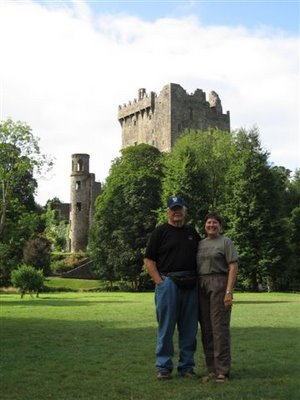
I don’t know if my eloquence of speech has improved since I did that or not. It doesn’t seem to be making and big changes in my writing. When we got to the village of Blarney we went to the tourist information office first thing. We found out how to get to the Castle and what time it opened for tours. It was actually right there in the village and we could have walked if we had known how close it was. We walked around town a few minutes before we went and Mary took some pictures of the church, a couple of hotels and the Blarney Wool Mill and just some street scenes. It is really a neat little town.
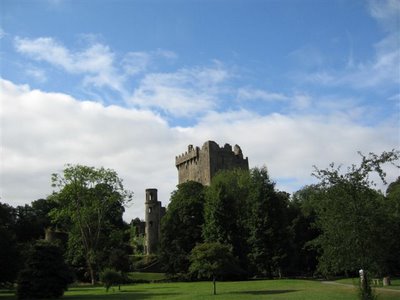
The Blarney Castle was built in 1446 and was owned by the same McCarthy family until 1690. It became the property of the governor of Cork in 1704 after several owners during William of Orange’s reign. Inside the grounds of the Blarney Castle we had almost a half mile walk to get to the actual ruins of the castle. The basic shape of the Castle was still there and it was pretty high. The rooms were labeled so you could tell a little about the organization of the house.
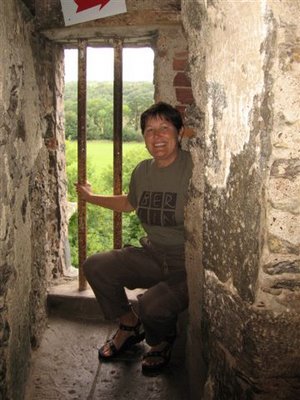
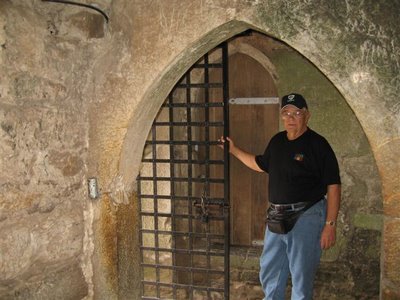
One thing which kind of stuck in my mind is the murder hole. It is a hole in the inside wall which allows the inhabitants to look down on invaders after the main entry has been breached and the enemy is inside. With the inner doors locked to stop the invasion they poured hot liquid down on the invading soldiers. We had to go all the way to the top to get to the Blarney stone. It is actually in the wall below the battlements, and you have to lie on your back, hold onto an iron bar and arch your back to get your head down low enough to reach the stone for a kiss.
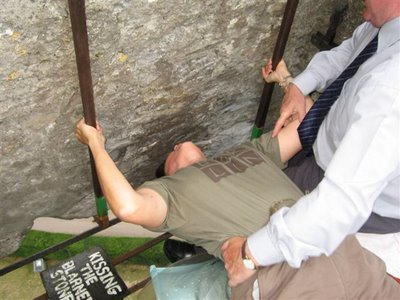
It wasn’t that difficult, but it scared some of the folks.
The grounds themselves were pretty with streams and stone bridges. There were several kinds of trees there and the they were all very old, and very large. There were plants and flowers along the way and large lawns. When we were up high so we could look down on the grounds it was easy to pick out the remains of walls that had been part of the Castle complex.
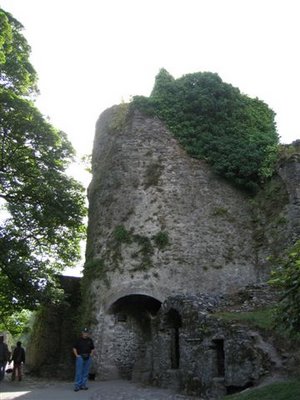

In the gift shop we picked up a couple of cards with the Brady Coat of Arms on them. I was surprised to read that the name was as common in Ireland as it is. It is in the top sixty most common names in all of Ireland and in the top forty most common in Ulster. We finished our visit to Blarney about noon so we decided to have lunch. Instead of going to a café we went to the deli in a supermarket and got a tub of tuna salad, some chips and some pastries. We got a coke to drink and went out onto the village green to have a picnic. We enjoyed it, but had to rush and cut it short because it rained.
We left Blarney and drove to Killarney in the early afternoon. We went to the tourist office in Killarney and got information about things we wanted to do in that area.
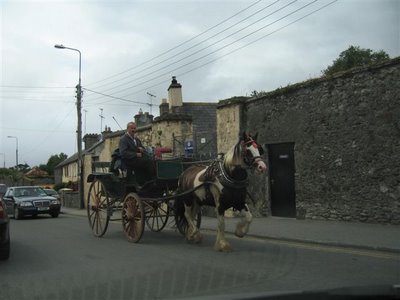
We had a reservation to overnight in Limerick so after we got out trip on the Ring of Kerry all lined up we left Killarney and went on to Limerick. It meant that we had to do some extra driving the next day, but we wanted to go to Limerick. We spent the night in a college dorm that was used as a hostel during June, July and August while the students were out of school for the summer. It was probably the newest building of any hostel we stayed in. As usual we had a private room but had to share a bathroom.
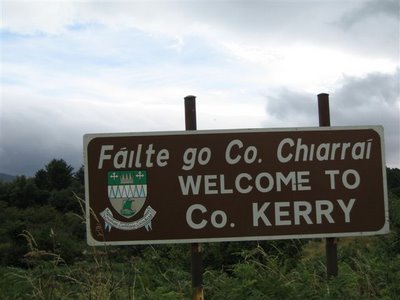
We had a beautiful drive all that day. Just about the line between County Cork and County Kerry we stopped at a pull out to take a picture. There was a great big blackberry patch off the road side so we just got us some cups and a paper sack and picked us a bunch of nice ripe blackberries.

Mary accused me of eating more than I put in the sack, but we had berries for the next three days.
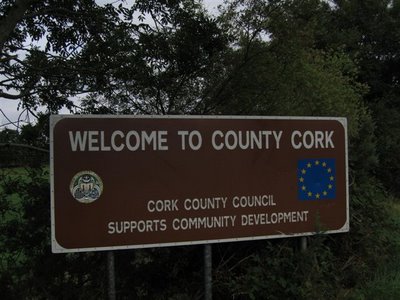
I guess we had about a two hour drive over to Limerick. It was all on a good road, but we did run into some road repair being done which slowed us down some.
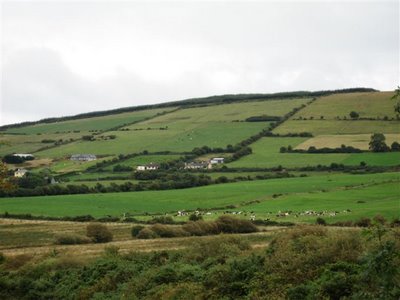
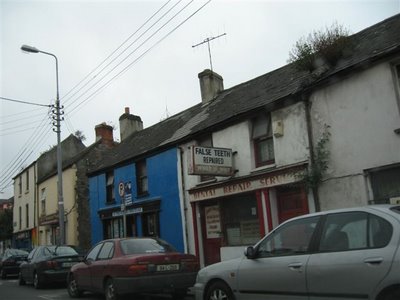
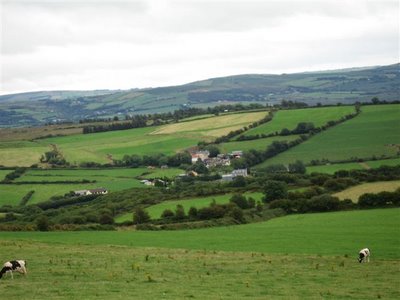
We passed through some pretty little towns and some really pretty countryside with farms and dairies.
When we got to Limerick we were in the rain and had been for an hour. I didn’t want to just wander around trying to find our hostel, so I stopped at a grocery store and used their phone to get good instructions on how to get there. We bought some things to snack on and went on to our place with no problems.
TUESDAY, CORK TO LIMERICK
On Tuesday morning we got up and had breakfast at the Finlay House, the hostel where we spent the night. We went out after breakfast and took some pictures. We got a picture of the outside of the hotel and we got a picture of the little street it was on which was a dead end. You could drive in from one end, but you had to walk up a flight of steps from the street below to get to it from the other side. The walls of the stair way are covered with graffiti and they approved it and even have it in their advertisement on the internet. It was a nice enough place to stay. We had a good clean place to sleep and a good breakfast and it was cheap. The neighborhood around the place is old European. It was hard to find and I ended up taking a page out of Sister and Lois’ travel book - I stopped at a fire house and they gave me perfect directions.
We went out of Cork much easier than we found the hostel. When we backed out of our street and got down to the main street level we were on the highway which led out to Blarney. We had to go to Blarney and kiss the Stone.

I don’t know if my eloquence of speech has improved since I did that or not. It doesn’t seem to be making and big changes in my writing. When we got to the village of Blarney we went to the tourist information office first thing. We found out how to get to the Castle and what time it opened for tours. It was actually right there in the village and we could have walked if we had known how close it was. We walked around town a few minutes before we went and Mary took some pictures of the church, a couple of hotels and the Blarney Wool Mill and just some street scenes. It is really a neat little town.

The Blarney Castle was built in 1446 and was owned by the same McCarthy family until 1690. It became the property of the governor of Cork in 1704 after several owners during William of Orange’s reign. Inside the grounds of the Blarney Castle we had almost a half mile walk to get to the actual ruins of the castle. The basic shape of the Castle was still there and it was pretty high. The rooms were labeled so you could tell a little about the organization of the house.


One thing which kind of stuck in my mind is the murder hole. It is a hole in the inside wall which allows the inhabitants to look down on invaders after the main entry has been breached and the enemy is inside. With the inner doors locked to stop the invasion they poured hot liquid down on the invading soldiers. We had to go all the way to the top to get to the Blarney stone. It is actually in the wall below the battlements, and you have to lie on your back, hold onto an iron bar and arch your back to get your head down low enough to reach the stone for a kiss.

It wasn’t that difficult, but it scared some of the folks.
The grounds themselves were pretty with streams and stone bridges. There were several kinds of trees there and the they were all very old, and very large. There were plants and flowers along the way and large lawns. When we were up high so we could look down on the grounds it was easy to pick out the remains of walls that had been part of the Castle complex.


In the gift shop we picked up a couple of cards with the Brady Coat of Arms on them. I was surprised to read that the name was as common in Ireland as it is. It is in the top sixty most common names in all of Ireland and in the top forty most common in Ulster. We finished our visit to Blarney about noon so we decided to have lunch. Instead of going to a café we went to the deli in a supermarket and got a tub of tuna salad, some chips and some pastries. We got a coke to drink and went out onto the village green to have a picnic. We enjoyed it, but had to rush and cut it short because it rained.
We left Blarney and drove to Killarney in the early afternoon. We went to the tourist office in Killarney and got information about things we wanted to do in that area.

We had a reservation to overnight in Limerick so after we got out trip on the Ring of Kerry all lined up we left Killarney and went on to Limerick. It meant that we had to do some extra driving the next day, but we wanted to go to Limerick. We spent the night in a college dorm that was used as a hostel during June, July and August while the students were out of school for the summer. It was probably the newest building of any hostel we stayed in. As usual we had a private room but had to share a bathroom.

We had a beautiful drive all that day. Just about the line between County Cork and County Kerry we stopped at a pull out to take a picture. There was a great big blackberry patch off the road side so we just got us some cups and a paper sack and picked us a bunch of nice ripe blackberries.

Mary accused me of eating more than I put in the sack, but we had berries for the next three days.

I guess we had about a two hour drive over to Limerick. It was all on a good road, but we did run into some road repair being done which slowed us down some.



We passed through some pretty little towns and some really pretty countryside with farms and dairies.
When we got to Limerick we were in the rain and had been for an hour. I didn’t want to just wander around trying to find our hostel, so I stopped at a grocery store and used their phone to get good instructions on how to get there. We bought some things to snack on and went on to our place with no problems.
Monday August 21st through Thursday 24th – The Rest of Ireland
MONDAY, DUBLIN TO CORK
On Monday we got up and had breakfast at the hotel before we left on our journey to Cork. We had some discussion about the best way to drive to Cork. We finally decided that we would see the real country better if we got off the major highways and saw all the small towns and villages on the way. We left the hotel and got on the M50 Motorway which is Dublin’s Interstate 285. It rings Dublin just like I 285 does Atlanta. We got out after the morning rush and it did not take us long to get to the south end of the city and get out onto the secondary roads which ran along the coast of the Irish Sea.
We passed through small towns that looked like small towns anywhere.
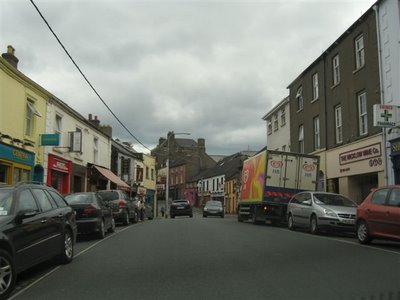
We also saw some buildings which you don’t see in a lot of small towns, unless you happen to be in a small town in Ireland.
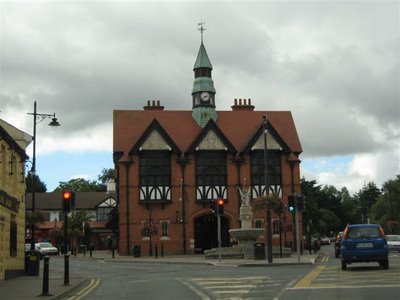
We saw a lot of local people and stopped and visited with some of them. You can learn a lot about the country doing this. The first place we stopped for any length of time for pictures was in a village named Greystones. They have a small harbor behind a sea wall which protects their bay.
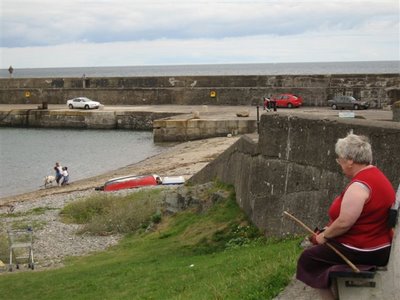
It appeared to be used mostly by fishing boats and sports and leisure boats.
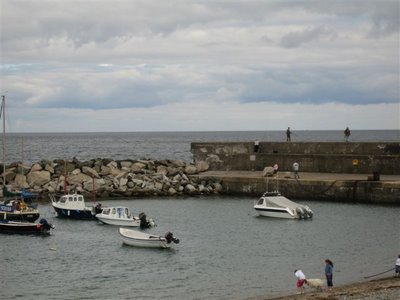
It was an active little town with a town square which had a monument to the men who went to sea.
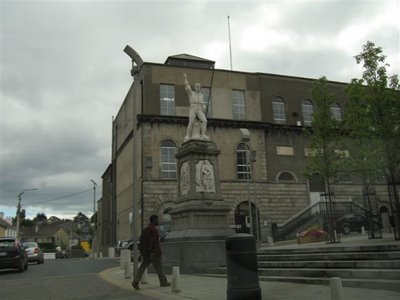
When we returned to the open road, we found a small diversion with a pretty area with a small golf course winding around a bay on some pretty extreme hills.
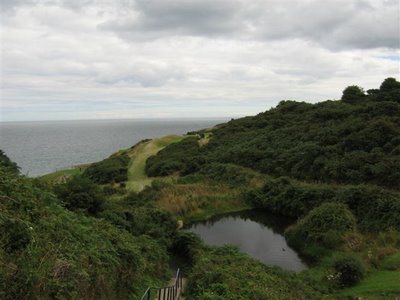
There was a walkway from the parking area which had several long sets of steps leading down to a rocky beach. It passed through the golf course and we actually went under a foot bridge which was used by the golfers to get from tee to green on a par three hole.
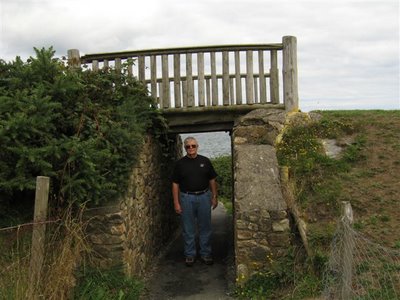
You know Mary and her trusty camera. We made friends with and photographed several of the golfers. I even got a picture of a beautiful mermaid sitting on a rock by the sea.
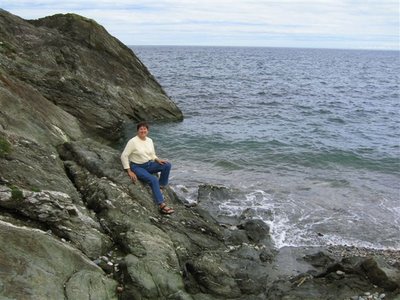
On the out skirts of the next village we found a very small, old church with a very large graveyard surrounding it.
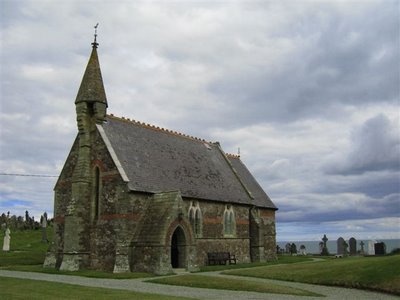
The graves in around the church were from the early 1800’s.
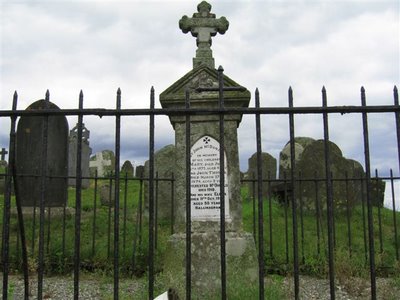
The newer section of the cemetery was farther up the hill. We pulled off the road and spent a few minutes just walking the hill and looking at the headstones. I didn’t see any Bradys, McBradys or O’Bradys. There may have been some.
It seemed that the farther we went the narrower the roads became and the higher the hedge row fences became. It got increasingly more difficult to drive and I was getting tired so the stops were more pleasant to me than they had been in the morning.
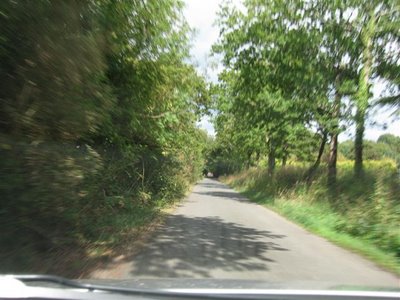
Just before we got to Wexford, we hit a bit of road which was so narrow that the trees overlapped over the road and made tunnels in some places. It was farm land with grain and hay mixed with dairy farms.

Some of the houses and farm buildings were very old and a lot of them had thatched roofs.
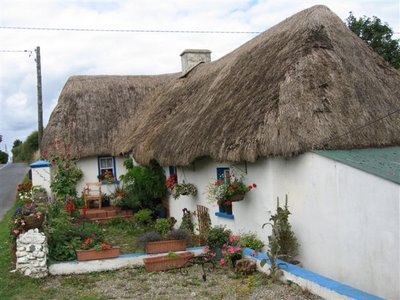
We thought it was all very Irish.
We took a good long break in Wexford. They have a large waterfront for such a small town. The tourist information office was out on the Quay in the Harbour.
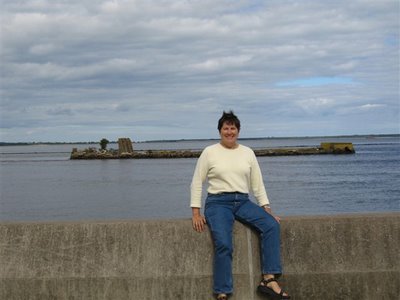
There was a large parking area on the quay, but it was all full so we drove on until we found parking on the street. We walked back down the waterfront to the tourist information office. On the way we passed a small Class C Motor Home parked on the Quay. There was an elderly couple sitting inside with a window open. I stopped and went back and Mary came over with me. I knocked on the wall and we introduced ourselves. They were just sitting there having a beer in the mid afternoon.
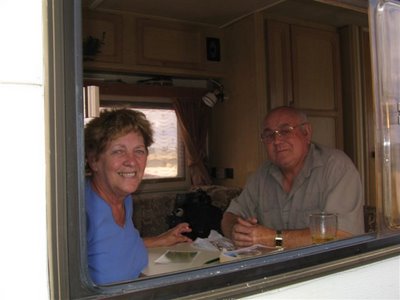
We had a very nice visit through their kitchen window. We told them about full time RV’ing . They are from England and came over on the ferry to spend a few weeks on holiday in Ireland. The guy said they didn’t like caravan parks, which they call RV Parks, so they just found large public parking areas to camp. We noticed this all over Europe; campers would be pulled off just in wide spots beside the road, or in closed service stations.
We walked around the town for a while and there are a couple of things of note. First there was a potato market on the front street.
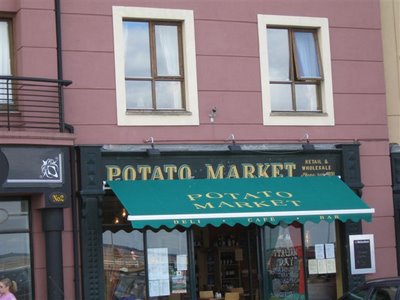
I was glad to see that. We even saw several farms which appeared to have fairly large potato fields. They did not compare to the number of potato farms we saw in Idaho. Of course, Ireland is probably not as large as Idaho. There was also an impressive statue of the Quay honoring Commodore John Barry.
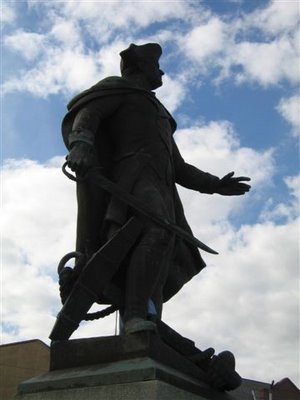
In 1776 Barry commanded the first American Navy vessel to capture a British ship. In 1783 Barry’s ship fired the last shot by a warship in the Revolutionary War. From 1794 until he died in 1803 he was the Senior Commodore of the US Navy. The monument was presented by the United States in 1956 to honor the contributions which Barry, a native of Wexford, made to the US Navy. On the way out of town we passed a business of one of the family, possibly!!

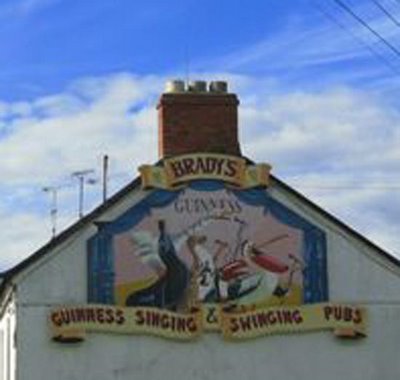
We passed through Waterford late in the afternoon. It is not a large city, but it is very pretty. The streets are built like many European towns, all crowded and curved. We passed Yeats College,
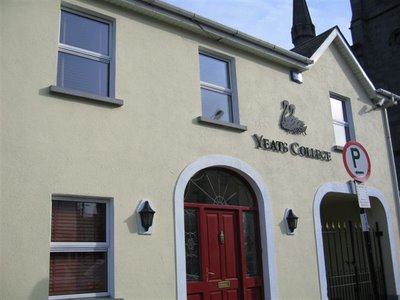
and the Waterford Crystal Plants.
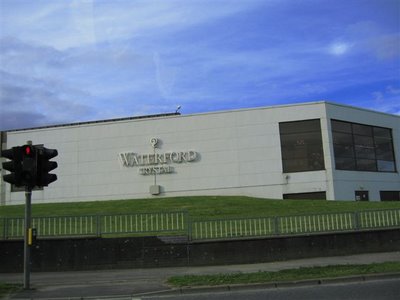
There is a Castle in Waterford which we had considered as an overnight spot, but it was a little costly so we changed our mind. From Waterford on toward Cork the countryside became increasingly more scenic. Just outside Waterford we came to the small port town of Dungarvan. It was getting near dark and we stopped here for a traditional Irish dinner at McDonalds before we rushed on to Cork. It was almost too late for pictures, but we stopped up on top of a hill and Mary took some pictures back into a valley and got Dungarvan, the Bay and the Irish Sea.

MONDAY, DUBLIN TO CORK
On Monday we got up and had breakfast at the hotel before we left on our journey to Cork. We had some discussion about the best way to drive to Cork. We finally decided that we would see the real country better if we got off the major highways and saw all the small towns and villages on the way. We left the hotel and got on the M50 Motorway which is Dublin’s Interstate 285. It rings Dublin just like I 285 does Atlanta. We got out after the morning rush and it did not take us long to get to the south end of the city and get out onto the secondary roads which ran along the coast of the Irish Sea.
We passed through small towns that looked like small towns anywhere.

We also saw some buildings which you don’t see in a lot of small towns, unless you happen to be in a small town in Ireland.

We saw a lot of local people and stopped and visited with some of them. You can learn a lot about the country doing this. The first place we stopped for any length of time for pictures was in a village named Greystones. They have a small harbor behind a sea wall which protects their bay.

It appeared to be used mostly by fishing boats and sports and leisure boats.

It was an active little town with a town square which had a monument to the men who went to sea.

When we returned to the open road, we found a small diversion with a pretty area with a small golf course winding around a bay on some pretty extreme hills.

There was a walkway from the parking area which had several long sets of steps leading down to a rocky beach. It passed through the golf course and we actually went under a foot bridge which was used by the golfers to get from tee to green on a par three hole.

You know Mary and her trusty camera. We made friends with and photographed several of the golfers. I even got a picture of a beautiful mermaid sitting on a rock by the sea.

On the out skirts of the next village we found a very small, old church with a very large graveyard surrounding it.

The graves in around the church were from the early 1800’s.

The newer section of the cemetery was farther up the hill. We pulled off the road and spent a few minutes just walking the hill and looking at the headstones. I didn’t see any Bradys, McBradys or O’Bradys. There may have been some.
It seemed that the farther we went the narrower the roads became and the higher the hedge row fences became. It got increasingly more difficult to drive and I was getting tired so the stops were more pleasant to me than they had been in the morning.

Just before we got to Wexford, we hit a bit of road which was so narrow that the trees overlapped over the road and made tunnels in some places. It was farm land with grain and hay mixed with dairy farms.

Some of the houses and farm buildings were very old and a lot of them had thatched roofs.

We thought it was all very Irish.
We took a good long break in Wexford. They have a large waterfront for such a small town. The tourist information office was out on the Quay in the Harbour.

There was a large parking area on the quay, but it was all full so we drove on until we found parking on the street. We walked back down the waterfront to the tourist information office. On the way we passed a small Class C Motor Home parked on the Quay. There was an elderly couple sitting inside with a window open. I stopped and went back and Mary came over with me. I knocked on the wall and we introduced ourselves. They were just sitting there having a beer in the mid afternoon.

We had a very nice visit through their kitchen window. We told them about full time RV’ing . They are from England and came over on the ferry to spend a few weeks on holiday in Ireland. The guy said they didn’t like caravan parks, which they call RV Parks, so they just found large public parking areas to camp. We noticed this all over Europe; campers would be pulled off just in wide spots beside the road, or in closed service stations.
We walked around the town for a while and there are a couple of things of note. First there was a potato market on the front street.

I was glad to see that. We even saw several farms which appeared to have fairly large potato fields. They did not compare to the number of potato farms we saw in Idaho. Of course, Ireland is probably not as large as Idaho. There was also an impressive statue of the Quay honoring Commodore John Barry.

In 1776 Barry commanded the first American Navy vessel to capture a British ship. In 1783 Barry’s ship fired the last shot by a warship in the Revolutionary War. From 1794 until he died in 1803 he was the Senior Commodore of the US Navy. The monument was presented by the United States in 1956 to honor the contributions which Barry, a native of Wexford, made to the US Navy. On the way out of town we passed a business of one of the family, possibly!!


We passed through Waterford late in the afternoon. It is not a large city, but it is very pretty. The streets are built like many European towns, all crowded and curved. We passed Yeats College,

and the Waterford Crystal Plants.

There is a Castle in Waterford which we had considered as an overnight spot, but it was a little costly so we changed our mind. From Waterford on toward Cork the countryside became increasingly more scenic. Just outside Waterford we came to the small port town of Dungarvan. It was getting near dark and we stopped here for a traditional Irish dinner at McDonalds before we rushed on to Cork. It was almost too late for pictures, but we stopped up on top of a hill and Mary took some pictures back into a valley and got Dungarvan, the Bay and the Irish Sea.
